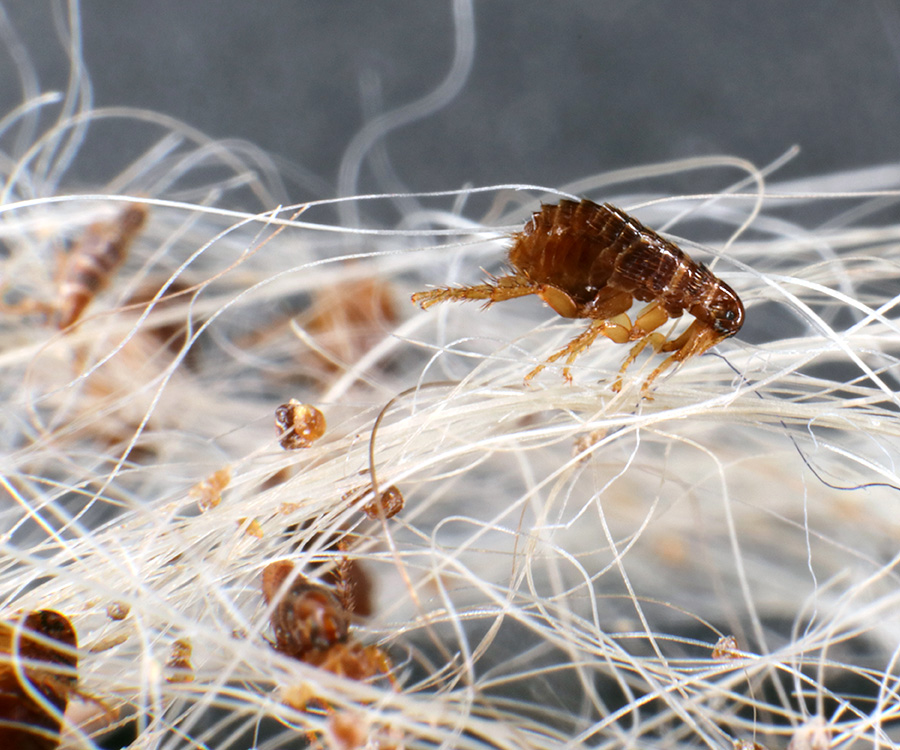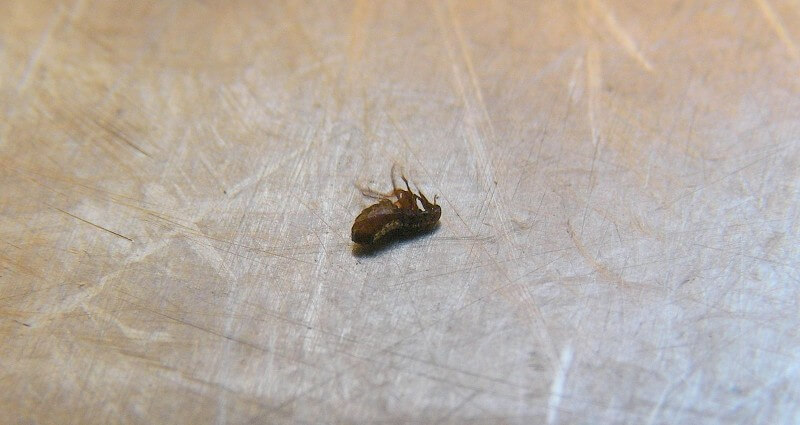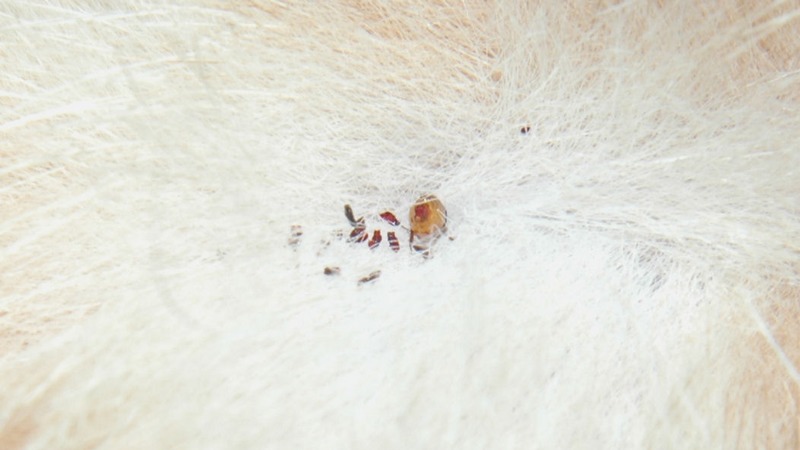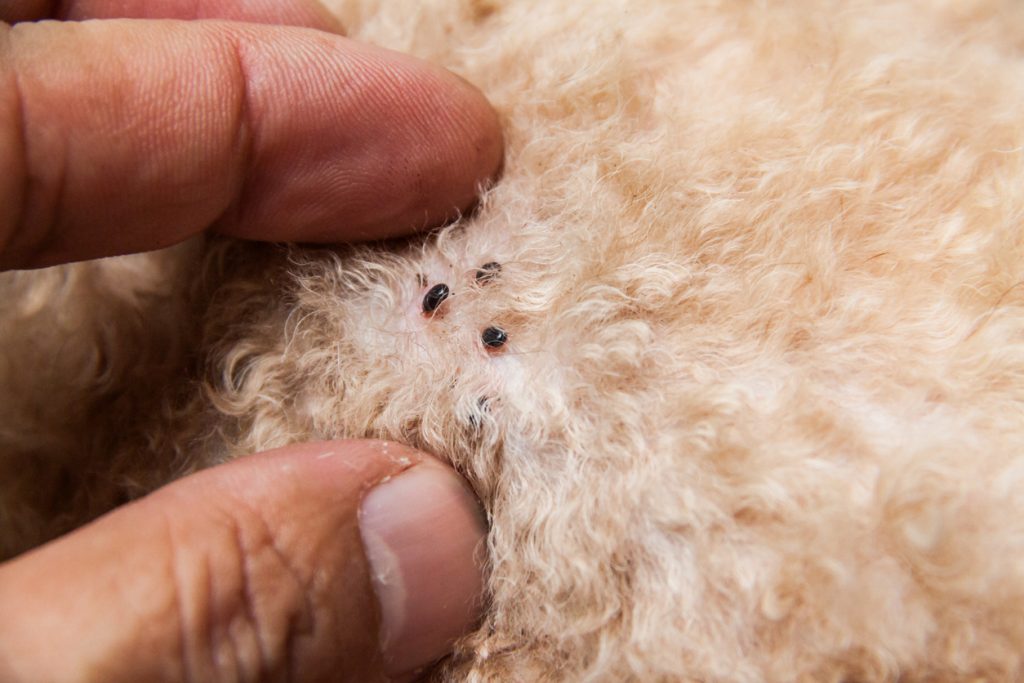Discovering fleas in your bed is more than a minor inconvenience. It’s a direct intrusion into your private space, a signal that your home is no longer fully under your control. Many people think of fleas as a pet problem only. But when these parasites move beyond fur and collars and into your sheets and mattress seams, it becomes personal. Understanding signs of fleas in your bed isn’t just about identification. It’s about regaining your peace of mind — and doing so in a way that’s informed, precise, and effective.
Can Fleas Really Live in Your Bed?
Yes, fleas can live in your bed, but not in the same way bed bugs do. Fleas don’t make nests or burrow into fabrics. Instead, they use your bedding as a temporary hiding place or a breeding ground, especially if your pets frequently share your bed.
Beds are warm, dark, and often lined with organic debris like dead skin cells and pet dander. This makes them ideal for flea eggs, larvae, and even pupae. While adult fleas prefer to live on a host, the immature stages thrive in soft materials. If you have pets that scratch often or sleep beside you, it’s likely that some part of the flea life cycle is playing out in your bedding.
Fleas don’t need long to establish a presence. Eggs laid on pets fall into bedding easily. Once there, larvae hatch and feed on flea dirt, maturing quickly if the environment stays humid and warm. The mattress becomes an unintentional incubator.
Why Fleas Leave Pets and Hide in Bedding

Fleas don’t abandon a pet without reason. They usually leave when disturbed — such as during grooming or itching. When this happens, they jump to nearby surfaces like blankets or sheets. If your pet rests on your bed, your bedding becomes the next best thing.
Bedding offers the kind of calm, hidden space fleas need for development. Larvae avoid light and burrow into dark seams or folds. Meanwhile, the adult fleas wait nearby for another chance to jump onto a warm host.
This isn’t just about pets. Even in homes without animals, fleas can be introduced by visiting pets or through infested clothing. Once they’re inside, they look for the safest and most stable environment to survive. Beds often top that list.
How Long Fleas Can Survive on Fabric Surfaces
Fleas can survive several days to two weeks on fabric surfaces, depending on humidity and temperature. Eggs and larvae survive longer than adults because they don’t need blood to grow. Pupae can stay dormant for weeks and hatch when they sense movement or heat.
This resilience means your sheets could look clean while hiding developing fleas beneath the surface. High thread-count sheets and padded comforters may even trap heat, creating a more favorable habitat.
Without proper intervention, a bed can sustain multiple flea life cycles. Vacuuming once or washing bedding occasionally isn’t enough to stop them completely.
Common Signs of Fleas in Your Bed
Small Black Specks (Flea Dirt)
The first thing most people notice isn’t a flea. It’s the black specks they leave behind. Flea dirt is dried blood, excreted after feeding. It looks like pepper flakes and tends to gather where pets sleep or lounge.
In beds, you’ll often find it near seams, pillow edges, or where your pet curls up. If you pick up the specks and place them on damp tissue, they’ll leave behind a reddish stain — a clear confirmation that it’s flea waste.
Flea dirt is not harmless. Its presence means adult fleas have fed and likely laid eggs nearby. Ignoring it allows the cycle to continue unchecked.
Tiny White Flea Eggs or Larvae
Flea eggs are very small, white, and oval-shaped — about the size of a grain of salt. Larvae resemble thin, wriggling worms and prefer hidden, dark places. Both stages can be embedded deep in fabric folds, mattress creases, and pillowcases.
Because they’re not easily visible, people often overlook them. But once eggs fall into bedding, they hatch within days. Larvae feed on flea dirt, continuing the infestation quietly while you sleep.
Finding these early stages requires careful inspection or even magnification. Still, if you see flea dirt, assume eggs and larvae are nearby.
Itchy Red Bite Marks on Skin
Flea bites are a physical reminder that something isn’t right. They appear as small, red, itchy bumps, usually in groups or lines. You’ll often notice them on your legs, ankles, arms, or waist — wherever skin is exposed while sleeping.
Unlike mosquito bites, flea bites itch almost instantly. They’re also smaller and tend to have a red halo. If you wake up with fresh bites despite not seeing insects, fleas are a likely cause.
For some people, these bites are more than an annoyance. Allergic reactions can cause swelling or blistering. Scratching increases the risk of infection.
Fleas Jumping or Moving on Sheets
Seeing live fleas is the most obvious sign. Adult fleas are about 2 to 3 millimeters long, fast-moving, and capable of jumping up to 8 inches. If you disturb the bedding and spot movement, you’re likely looking at a live infestation.
You might notice them when changing sheets or after your pet shakes off. They can appear as small, dark, fast-moving specs that vanish quickly into fabric seams.
If you see one, there are more. Fleas reproduce rapidly, and visible adults often mean larvae and eggs are nearby.
Pets Scratching More Than Usual Around the Bed Area
If your cat or dog starts scratching excessively around the bed, take it seriously. This is one of the earliest behavioral signs of a flea problem. Pets will often avoid the bed, act restless, or groom specific areas repeatedly.
This isn’t random. Pets react to the sensation of being bitten. Their discomfort indicates that fleas are not only on their bodies but also in their sleeping environment — which could be your bed.
Changes in pet behavior around your bed should prompt a close inspection. It’s not just about treating the animal — your bedding is part of the problem.
What Flea Bites Look Like on Humans

Appearance and Common Bite Locations
Flea bites look like tiny, red, raised spots. They usually appear in clusters or straight lines, most commonly on lower legs, ankles, feet, and sometimes the waist or forearms. These are areas easily exposed during sleep.
The itching is intense and starts almost immediately. Bites can also have a red halo, which helps differentiate them from other insect bites. The marks are persistent and often multiply overnight.
Repeated exposure causes sensitization in some people. That means over time, the bites may get itchier, larger, or take longer to heal.
How to Tell Flea Bites from Bed Bug Bites

Both pests leave behind itchy, red bumps — but there are clear differences. Flea bites usually target the lower body and itch right away. Bed bug bites appear higher on the body, often in symmetrical rows, and the itching is delayed.
Flea bites are more random, scattered, and smaller. Bed bug bites swell more and often appear on the face, arms, or neck. Your pet’s behavior also helps clarify. Bed bugs don’t affect pets. Fleas do.
If your pet is scratching and you have bites on your ankles, it’s highly likely fleas are the issue.
How Fleas Get into Beds
Pets as the Primary Source
Pets are the most common entry point for fleas into your home — and eventually, your bed. When cats or dogs sleep on your bedding, fleas naturally follow. They feed, breed, and lay eggs that fall into the sheets.
Each time your pet jumps onto the bed, they’re potentially dropping flea eggs into the fabric. Over time, these turn into larvae and then adult fleas, restarting the infestation.
Regular pet treatment is essential. Otherwise, your bed becomes an extension of your pet’s flea problem.
Fleas Hitchhiking on Clothing or Blankets
Even without pets, fleas can enter your home. They attach to shoes, clothes, or secondhand fabrics like blankets and furniture. Once inside, they seek out warm, soft areas — and your bed fits that profile.
If you’ve spent time in a flea-infested environment (parks, shelters, or other homes), you can bring fleas back with you. They transfer from fabric to fabric easily.
Washing clothes and blankets immediately after exposure helps reduce the chance of infestation.
How to Confirm You Have Fleas in Your Bed
White Sheet or Sock Test
Place a clean white sheet over your bed and shake the mattress. Wait and watch. Fleas, if present, will jump and become visible against the white fabric.
You can also wear long white socks and slowly walk across the carpet near the bed. Fleas are drawn to warmth and motion. They’ll jump onto the socks, making them easy to spot.
These tests are simple but effective — especially in early stages of infestation.
Flea Comb and Light Inspection
Use a flea comb on your pet and check what falls off onto a white surface. Look for live fleas, flea dirt, or eggs. This confirms that your pet is the source.
Inspect your bed with a flashlight. Focus on seams, folds, and corners. Fleas prefer dark, tight spaces. You may also see movement or dried flea debris.
Comb and light tests work best together for accurate detection.
Checking Seams, Pillows, and Mattress Edges
Fleas prefer edges and undisturbed areas. Check mattress seams, pillow zippers, and the edges of fitted sheets. Look for flea dirt, eggs, or movement.
If you lift the mattress or shake the sheets and notice small particles or fast-moving specks, that’s a clear sign of activity.
The infestation may be deeper than it appears. Seams hide eggs and larvae that vacuuming often misses.
How to Get Rid of Fleas in Your Bed
Wash Bedding in Hot Water
Remove all bedding and wash it in hot water (at least 60°C). Heat kills fleas at every stage — eggs, larvae, and adults. Dry on the highest heat setting for at least 30 minutes.
Include sheets, pillowcases, blankets, and mattress covers. Wash pet blankets or toys as well if they’re near the bed.
Repeat weekly until no signs remain.
Vacuum Mattress and Surrounding Area
Vacuum your entire bed — top, sides, seams — as well as nearby carpets and rugs. Fleas hide in tight spaces, so use the crevice tool to get into corners.
Dispose of vacuum bags or contents immediately in an outdoor bin. Flea eggs can survive inside the vacuum if not handled correctly.
Daily vacuuming for 10–14 days helps break the life cycle.
Use Flea Spray or Natural Remedies Safely
Choose sprays with insect growth regulators. These prevent larvae from becoming adults. Ensure the product is safe for use on bedding.
Natural remedies can help but are not replacements for full treatments. Diatomaceous earth is effective on surfaces. Essential oils like cedarwood or eucalyptus can deter fleas — but test small areas first.
Avoid soaking your mattress or pillows. Light applications are safer and more effective.
Treat Pets Simultaneously
You must treat your pets while treating the bed. Use vet-recommended spot treatments, oral meds, or flea collars. Treat every pet in the household — not just the ones with visible fleas.
Fleas lay up to 50 eggs a day. If pets remain untreated, the cycle will start again in your clean bed.
Ask your vet for a year-round prevention strategy.
Preventing Fleas from Returning to Your Bed
Regular Pet Treatments and Grooming
Use monthly flea prevention on all pets, regardless of season. Fleas thrive in warm indoor environments year-round.
Brush your pet with a flea comb weekly and watch for signs like scratching or biting. Bathe them regularly and keep fur trimmed.
A consistent grooming routine is your best long-term defense.
Cleaning Routines and Bedding Rotation
Wash bedding weekly in hot water. Vacuum bedrooms, especially around pet areas. Rotate between two or three sets of bedding to ensure nothing is missed.
Declutter under and around the bed. Fleas use undisturbed zones to hide and reproduce.
Stay consistent. Prevention only works when it’s part of a routine.
When to Call a Pest Control Professional
If the infestation spreads or continues despite repeated treatments, call a licensed pest control expert. They use professional-grade products and inspect hard-to-reach areas.
This is essential when fleas have spread to floorboards, wall cracks, or furniture. Professionals also provide follow-up plans for complete eradication.
Waiting too long increases the cost and duration of treatment.
Conclusion: How to Detect and Eliminate Fleas from Your Bed for Good
Getting rid of fleas in your bed takes more than one cleaning. Start with hot water washes, daily vacuuming, and safe sprays. Treat pets at the same time and monitor every part of your bed closely.
Once you eliminate the problem, stick to prevention. Use flea protection on pets, rotate bedding, and inspect regularly. If the problem returns, don’t hesitate to bring in expert help.
Your bed should be a place of rest — not a hiding spot for parasites. With the right strategy, it will be again.
